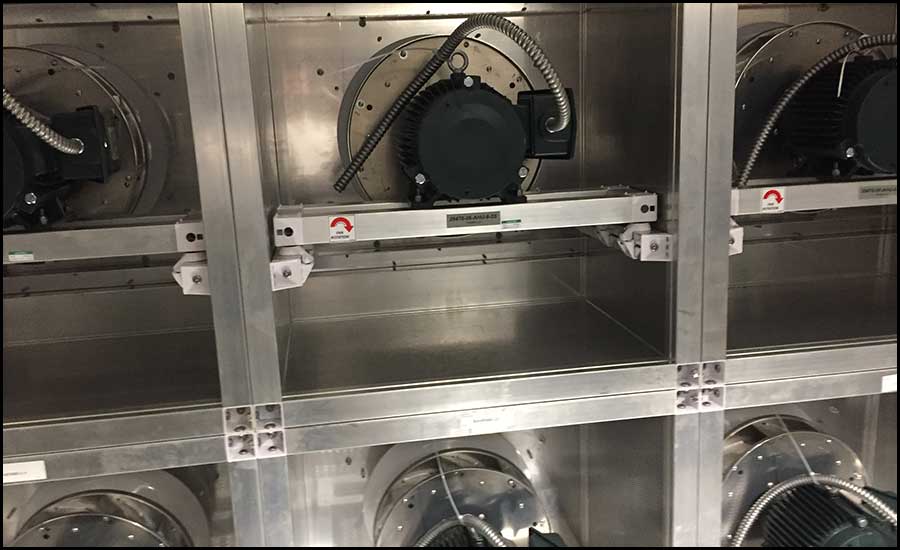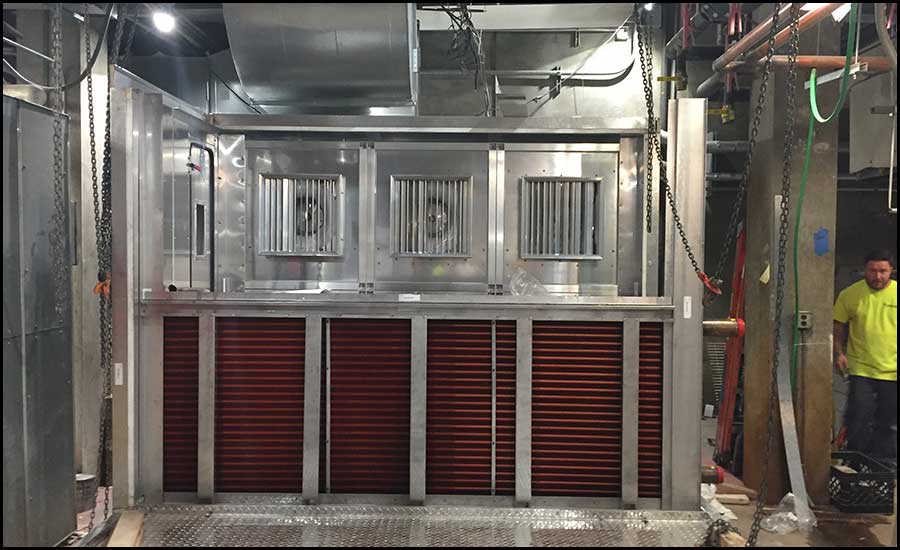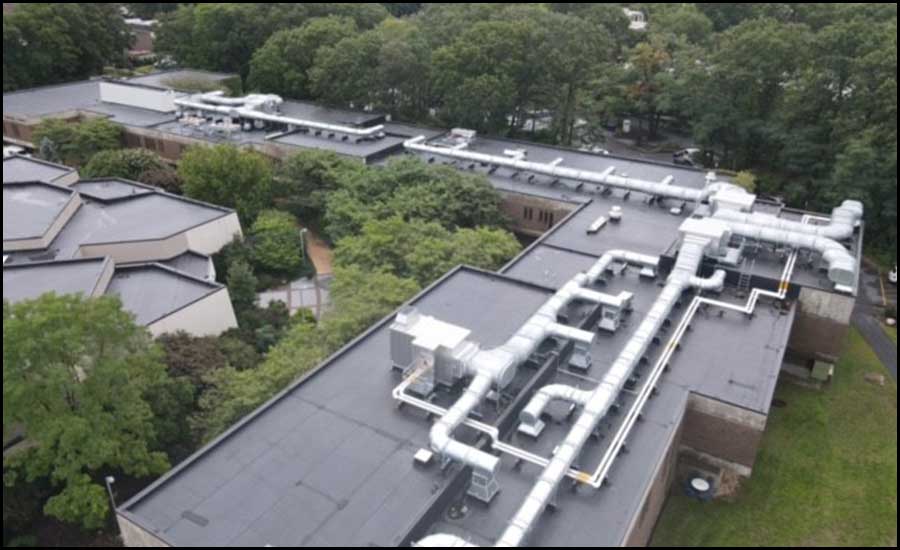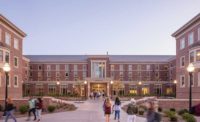RMF Engineering has a long-standing relationship with The State University of New York (SUNY) system of public colleges and universities. This relationship provides an ongoing body of work that includes the engineering firm's completion of four major air handling units (AHU) and infrastructure replacement projects over the past decade with one additional currently in progress. All five projects were based on HVAC systems that were over 40 years old, some of which were constructed as far back as the late 1960s, that had far surpassed their expected service lives.
RMF’s team of engineers studied the original drawings of each of the impacted buildings, as well as those of the systems themselves, to determine the best path forward. Given the nuances of each system and the limitations posed by the existing structures that housed them, customization was critical to RMF's approach. The resulting strategies were uniquely tailored to their existing mechanical spaces through the use of custom knock-down units and fan array technologies that provided system longevity and ease of maintenance.
In order to limit the amount of disruption on campus, RMF's approach was phased with both temporary and permanent solutions to ensure no building, campus service, or field of study was taken offline during the series of upgrades. RMF utilized temporary AHUs in different buildings to help keep the spaces operational while construction was in progress. Additionally, hydronic pumps and heat exchangers were replaced in a few buildings to improve water flow and temperature. All systems were provided with state-of-the-art controls to maximize energy savings including variable frequency drives (VFDs) for all pumps and fans, temperature resets for all AHUs and HXs and carbon dioxide sensors to control and optimize outside air during noneconomizer cycles.

One of the key methods of the renovation was the use of knock-down construction. New AHUs were assembled and tested at a manufacturing plant and broken down into multiple pieces for shipping and reassembly on the Stony Brook campus. This allowed the team to de-construct and construct targeted units while strategically keeping existing units online and utilize temporary units to serve the de-constructed units. The knock-down construction method was used consistently on the campus for each renovated building and using the building’s existing elevators and building entrances to bring the unit components into the mechanical room to be constructed in-place.
RMF's scope of work for these projects included HVAC system replacements for the graduate physics building, Administration Building, the Educational Communications Center, Math Building, and Computer Science / Laboratory Office Building.
The Graduate Physics Building
The challenge of this 1970s-era building prohibited a replacement in-kind approach forcing the team to expand their bandwidth to include the replacement of custom return fan sections for many of the air handler systems due to space. Further, the building is occupied daily both for instruction and scientific studies. This led to the design of the four AHU replacements, allowing the building to remain operational during construction. The use of two outdoor temporary AHU units (2 units at 30,000 cfm each) and interconnecting ductwork between the permanent system air handlers with strategic cutovers to basement units AHU9 and AHU11.

Working within the building's extremely tight mechanical spaces, RMF created 480,000 Cubic Feet Per Minute (CFM) of custom air handlers, through the use of fan wall technology that replaced the 40-year-old ventilation single fan air handlers and return air units to create a more efficient building airflow distribution system.
This modular fan wall technology was constructed in small component sizes and included exceptional energy conservation and control through individual fan modulation. This strategy optimizes the limited square footage available, making for a more reliable system and a maintenance-friendly mechanical space, which now can accommodate newer HVAC technology and provide “N+1” redundancy for each AHU
The University Administration Building
The original air handling units for this building that dates back to the 1960s had reached the end of their lives. Another sign of the aging units was the lack of a HVAC heat recovery system. Utilizing a "knock-down construction" method while keeping the building fully operational, RMF fully overhauled the system, provided new heating and cooling functionality, and integrated the upgrades into the larger, campus-wide system.
The new equipment included 133,000 CFM of AHU systems that were assembled and tested at a manufacturing plant and broken down into multiple pieces for shipping and reassembly on-site. All of the new AHUs and pumps were integrated into the campus-wide Siemens Building Automation System (BAS). The redundancy of AHUs originally present in the design allowed for cross-connections of ducts to supply air to the renovated areas temporarily while their respective, permanent AHUs were replaced.
The Educational Communications Center
RMF used a similar approach for SUNY’s Educational Communications Center, also built in the 1960s, as it did on the administration building. By leveraging the “knock-down construction” method, the building remained operational and allowed workers to use existing elevators and building entrances to bring unit components into the mechanical room. The four AHU’s totalling 112,000 CFM were replaced one at a time to minimize downtime.
Additionally, a new high-temperature hot water (HTHW) to low-temperature hot water (LTHW) converter and associated pumping system was designed to serve the AHU preheat and re-heat capacity for the building. The university also requested to isolate the central chilled water loop through the use of plate and frame heat exchangers and secondary pumps.
The Math Building
Due to original drawings being inaccurate, RMF designed a new concept that would replace the 40-year-old ventilation air handler and induction units to combine the two systems. Currently under construction, this strategy optimizes the extremely tight mechanical square footage space available, which wouldn't be able to accommodate newer HVAC technology, to make for a more reliable system and a maintenance-friendly mechanical space. Although induction units are not a mainstream HVAC solution, replacing the old induction units with the modern version was the best solution considering existing space constraints.

Due to the modernization of induction units, RMF combined the once dedicated VAV and induction unit air handlers into a single VAV air handler that serves both the induction units and VAV units. Once again the use of fan wall technology allowed RMF to reduce the tunnel length of the air handling unit to incorporate a return air fan module fitted with a fan array.
The Computer Science / Laboratory Office Building
The Computer Science and Lab Building presented a particularly unique challenge, given that it serves as a home for animal holding areas, classrooms, teaching labs, research labs, lecture halls, computer lab, offices, and conference rooms. In order to address the needs of each function, RMF designed and replaced the building's 45-year-old system of six constant volume AHUs, five of which were custom-made, totaling 138,000 CFM. In an effort to save energy, all but one was converted from 100% outside air to return air units.
The return system ductwork would not fit into the existing ceiling cavity and therefore a number of return air fan wall modules were roof mounted for each air handler system. Return air shafts routed between the basement-located AHUs and the roof-mounted return air units were strategically located. The AHUs and return air modules were interconnected with return air ductwork on the roof.
Additionally, a new high-temperature hot water (HTHW) to low-temperature hot water (LTHW) converter and associated pumping system was designed to serve the AHU preheat and re-heat capacity for the building. The university also requested to isolate the central chilled water loop through the use of plate and frame heat exchangers and secondary pumps. The associated controls for the above scope were converted to Direct Digital Controls (DDC).





